Rhombus

In Euclidean geometry, a rhombus (◊), plural rhombi or rhombuses, is a simple (non-self-intersecting) quadrilateral whose four sides all have the same length. Another name is equilateral quadrilateral, since equilateral means that all of its sides are equal in length. The rhombus is often called a diamond, after the diamonds suit in playing cards, or a lozenge, though the former sometimes refers specifically to a rhombus with a 60° angle (see Polyiamond), and the latter sometimes refers specifically to a rhombus with a 45° angle.
Every rhombus is a parallelogram, and a rhombus with right angles is a square.
The word "rhombus" comes from Greek ῥόμβος (rhombos), meaning something that spins, which derives from the verb ρέμβω (rhembō), meaning "to turn round and round". The word was used both by Euclid and Archimedes, who used the term "solid rhombus" for two right circular cones sharing a common base.
© Symbols.com
